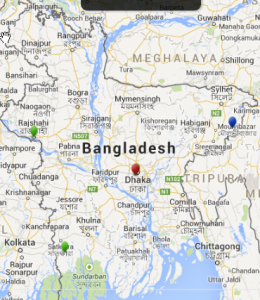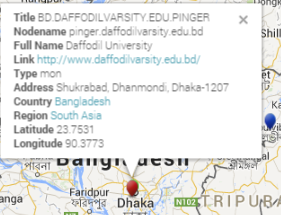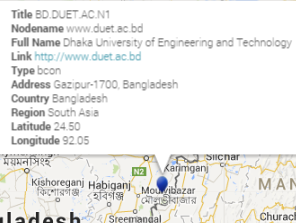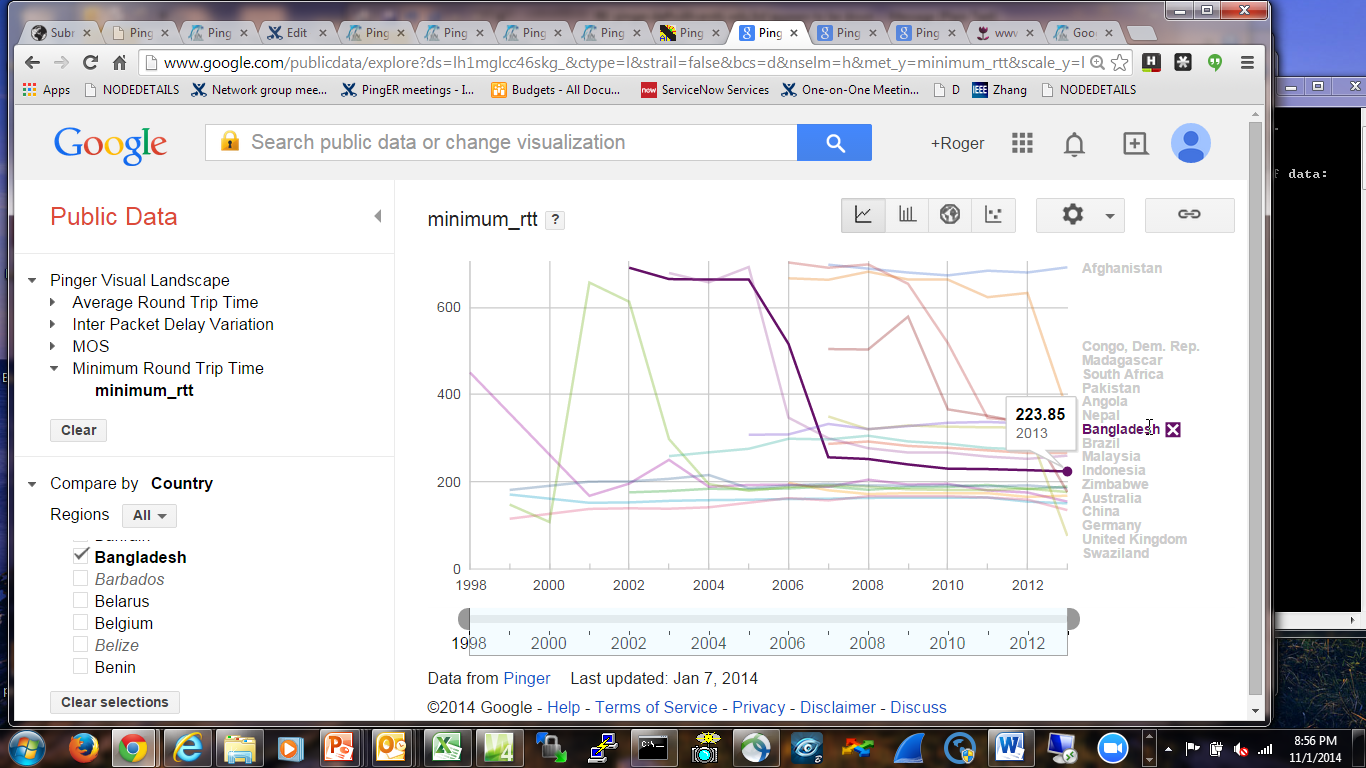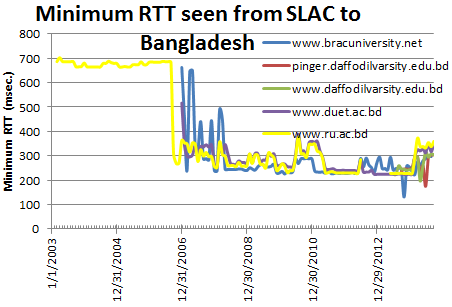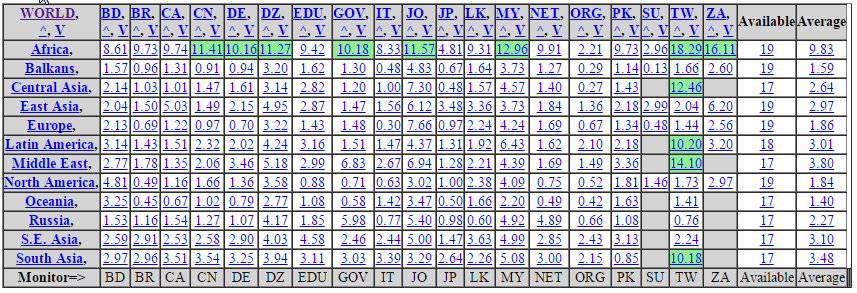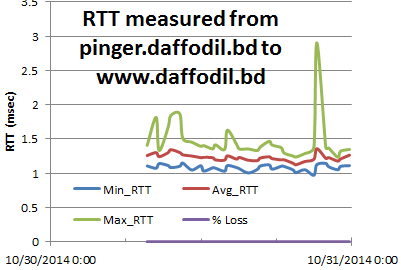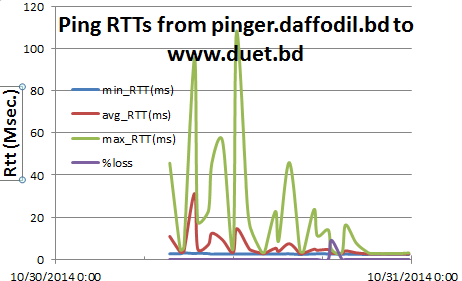Bangladesh PingER sites
SLAC monitors 4 sites in Bangladesh. They are seen below in the map.
Summary
- Connections between Pakistan and the two representative hosts (Beacons) in Bangladesh are very indirect going via Europe.
- The 4 Bangladesh hosts monitored from SLAC are not exhibiting diunral changes or jitter that would be indicative of congestion.
- In general the Internet performance from Bangladesh to other regions of the world, is similar to Pakistan's.
- One of the 4 sites ( Brac University) in Bangladesh monitored from SLAC is not responding.
- VoIP should work acceptably well between Daffodil International University and most sites in Europe, Middle East, N. America, Russia ans S. E. Asia.
- It appears Bangladesh switched over from using geo stationary satellite connections to terrestrial connection to the US in 2005-2006.
Bangladesh sites seen from SLAC
The ping Round Trip Times (RTTs) are seen below. We observe:
- The black bar (no data or host unreachable - 100% packet loss) observed 2014-09-05 in all plots is due to the host at SLAC being down and not making the measurements.
- The median RTTs seen from SLAC are relatively consistent from site to site and around 350ms,
- The lack of regular day vs night variations in the RTTs suggest that the links are not congested.
- The RTTs for each site are also relatively consistent (little jitter) with few large RTTs.
- Daffodil International University appears to have the lowest loss rates. i.e backgound color is usually cyan meaning no loss
- BRAC university was experiencing of lot of unreachability (black) and was no longer reachable towards the end of September.
- DUET experienced a lot of packet loss (note yellow and orange backgrounds) until mid August 2014.
- RU had a burst of lossiness (magenta background) between Oct 12 and Oct 15 29014.
- The spike in RTT seen 2014-09-24 indicates a possible common cause (ie. a link shared between all sites)
More detail for the Daffodil site are seen below:
Traceroutes from SLAC
The route from SLAC to Daffodil International University goes from SLAC to Palo Alto (3 miles away), to New York, London, Paris, Mumbai and Bangladesh.
The route to BRAC is similar.
The routes from SLAC to DUET and RU goes from SLAC and the San Francisco Bay Area to Dallas, Palermo Italy and thence to Bangladesh
Regions of the world seen from Daffodil International University Bangladesh
The column labeled BD below are the measurements of the various metrics made to other regions of the world from Daffodil International University for October 2014. Information on the meanings of the metrics can be found in the tutorial at http://www.slac.stanford.edu/comp/net/wan-mon/tutorial.html.
Derived TCP throughput
Derived_throughput = MSS /(RTT*sqrt(loss))
where MSS = Maximum Segment Size typically = 1460Bytes.
Average RTT
This mainly a function of the route length between the source and destination.
Loss
This is typically an edge effect.
Minimum RTT
This mainly a measure of the route length between the source and destination. All regions are reachable by terrestrial routes (i.e. no minimum RTT > 400ms).
Looking at the long term minimum RTT from SLAC to Bangladesh seen below it is apparent that the connection switched from using geostationary satellites (>450ms) to terrestrial connections (< 450ms) in 2006.
Looking in more detail at the minimum RTTs from SLAC to Bangladesh see the plot below showing the cut-over for the RU university on 11 October 2006 around 7:00am UDT. The spreadsheet is here.
Unreachability
If none of the pings sent each half hour respond then the target remote host is deemed unreachable. The plot below shows the monthly unreachability seen from SLAC to Bangladeshi hosts.
Jitter
This is typically an edge effect.
Mean Opinion Score
This is a function of the average RTT, the packet loss and the jitter. It indicates how god a phone call is expted to be. Typically with MOS values above say 3.6 calls become acceptable. Thus VoIP calls should be of acceptable via the Internet between Daffodil International University and the regions in yelolw and green in the table below.
Directivity
How direct the route is between a source (monitor) and destination (monitored/remote) site is given by the directivity index. A value of 1.0 indicates that the route is a great circle route between the sites. Smaller values indicate the route is less direct. It is seen that the routes between Daffodil International University and North America and Latin America are the most direct with values of 0.42 and 0.45. Other routes are more indirect, with the route to South Asia being the least direct.
Looking in a bit more detail at the connections between Daffodil International University and S. Asia we find:
- The one country with a reasonable Directivity (0.25) with Daffodil International University is Sri Lanka.
- The minimum RTT to Afghanistan is ~ 650msec indicating is probably connected via a geo stationary satellite link.
- Since the traceroute server at Daffodil International University is not working instead we look at the reverse routes to Daffodil International University from Pakistan. The route from Pakistan to Daffodil International University actually goes from Pakistan to Europe and then back to Singapore and Bangladesh hence accounting for the low value of Directivity. A similar result is seen for the route from Pakisan to Duet.
Round Trip times in Bangladesh
These are shown from between Daffodil International University hosts and from Daffodil International University to Duet.
The RTTs from pinger to www at Daffodil International University show that the Daffodil International University monitor pretty stable.
The distance as crow flies between pinger.daffodilvarsity.edu.bd and www.duet.ac.bd = 189.2 km. or a minimum RTT (as constrained by speed of light in fibre) = 1.892. the average minimum RTT from Daffodil International University to Duet is 2.55msec. This corresponds to a Directivity of 0.74, i.e. the route is pretty direct. The spreadsheet of the data from which the plots below were derived is here. The variability of the RTTs is much greater than that between hosts at the Daffodil International University site (first plot). Thus most of the variability is attributed to the route between Daffodil International University and Duet and possibly the host at Duet.
